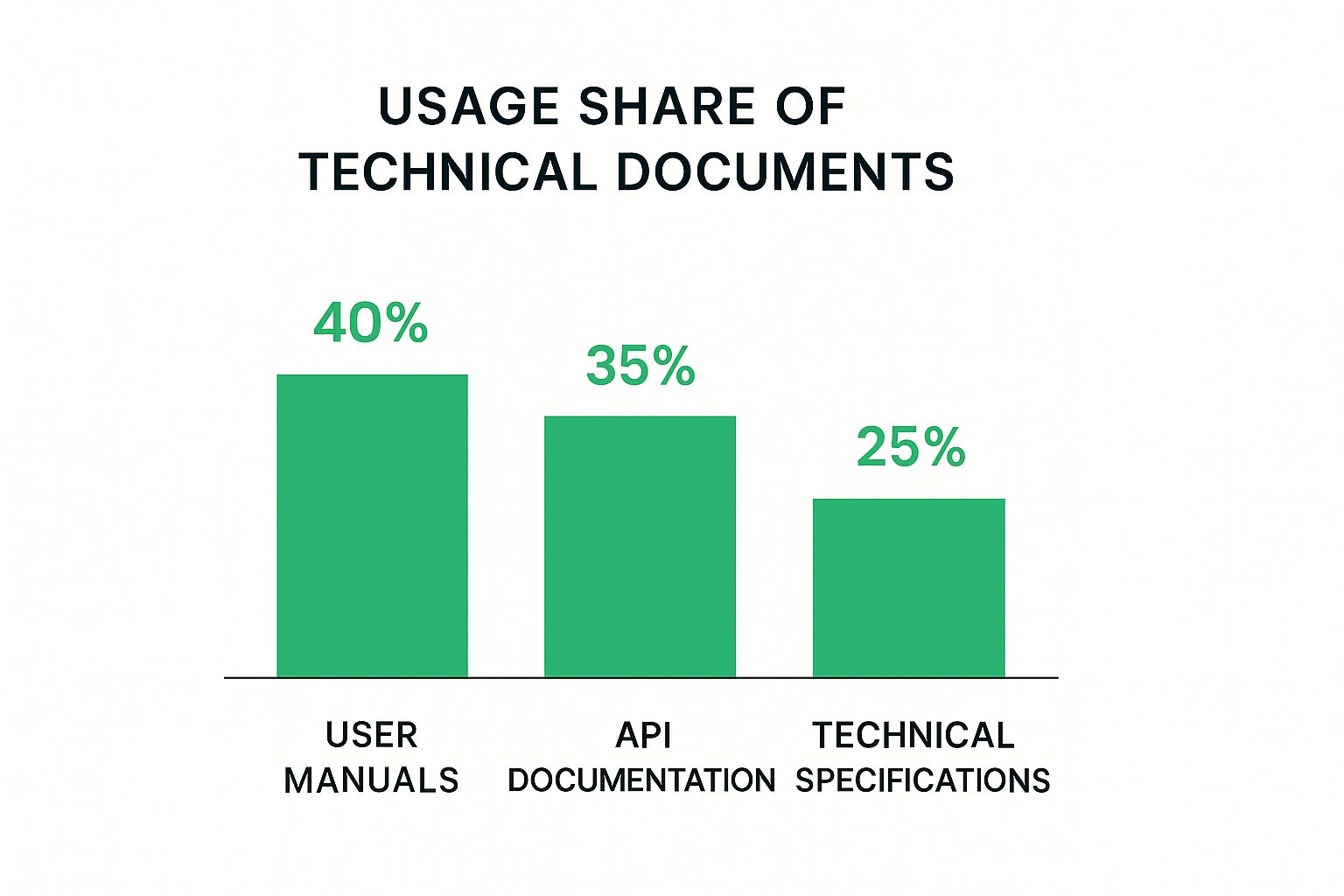Learn what are technical documents, their purpose, and how they can improve your business operations. Discover expert tips today!

Technical documents are much more than simple manuals. They are the bridge between complex information and clear understanding. They empower users to interact effectively with products, grasp intricate processes, and navigate regulatory requirements. It’s not just about listing steps; it’s about facilitating successful engagement with technology and systems.
What sets technical documents apart? Several key characteristics define their effectiveness. Accuracy is crucial, ensuring the information is verifiable and precise. Clarity ensures the intended audience can easily understand the message, avoiding jargon. Accessibility means the content is well-structured and easy to navigate. And finally, Usability ensures the document serves its purpose, allowing users to complete their tasks efficiently.
For instance, a software user manual isn’t just a feature list. It guides users through installation, setup, and operation, unlocking the software’s full potential. Rigorous review and update processes are essential to maintain accuracy and relevance, especially in the face of technological advancements.
From software development to healthcare, technical documents are essential. In manufacturing, they ensure product quality and worker safety by guiding assembly and maintenance. In software development, API documentation empowers developers to integrate and use software components seamlessly. Check out our guide on How to master technical writing. These documents are a cornerstone of the global document analysis market, valued at approximately USD 1.97 billion in 2023.
This market is projected to reach nearly USD 31.98 billion by 2031, with a CAGR of around 41.7%. This impressive growth is fueled by increasing digitization and the integration of AI and Machine Learning. Learn more about document analysis market growth. Furthermore, technical documents, including training materials and standard operating procedures, are crucial for organizational knowledge management.
Technical documents have come a long way from static printed manuals. They’ve evolved into dynamic digital resources, boosting accessibility and incorporating interactive features like search functionality, embedded videos, and real-time updates. The fundamental purpose remains: to provide clear, concise information that empowers users. You might be interested in: Understanding different types of technical documents. This shift towards digital has significantly improved information access and utilization, making technical documents more valuable than ever.
Technical documents are more than just static instructions. They’re dynamic tools that help everyone understand complex information and achieve better results. Choosing the right type of document is key to maximizing its impact. This involves understanding the wide range of technical documents available and tailoring your approach to your organization’s specific needs.
Technical documents come in various formats, each with a unique purpose:

This infographic shows the usage share of three main types of technical documents: 40% for User Manuals, 35% for API Documentation, and 25% for Technical Specifications. The high percentage of user manuals reflects the widespread need for clear product instructions. The significant portion dedicated to API documentation highlights the increasing importance of software integration in interconnected systems.
To further illustrate the variety and uses of technical documentation across industries, let’s examine a comparison table:
This table below shows common technical document types and their uses across different sectors.
This table shows the interconnectedness of these documents and their importance across various sectors. The impact of digital transformation is also evident, particularly in the shift towards more accessible and interactive formats.
Effective technical documents are those aligned with business goals. If your goal is to improve customer satisfaction, user-friendly manuals and online help resources are critical. If accelerating software adoption is the objective, clear and comprehensive API documentation becomes a necessity. This strategic approach ensures that documentation directly contributes to measurable business outcomes.
Effective technical documents, regardless of type, share key elements. Clarity is paramount, using concise and accessible language for the target audience. Accuracy, achieved through rigorous fact-checking and validation, is essential. A clear structure is also vital, organizing information logically for easy navigation. Finally, visuals, like diagrams and charts, can greatly enhance understanding, especially for complex technical concepts. You can find more details on this in our article on different types of technical documents and their uses. Combining these elements makes your technical documents not just informative, but truly usable and valuable.

Technical documents are often viewed as a necessary expense, but they can actually be a powerful asset. More than just manuals, they represent a strategic investment with a significant return on investment (ROI). Well-crafted documentation can positively impact your company’s bottom line. Let’s explore how. Tools like an AI Document Assistant Application can help manage and improve the quality of your technical documentation.
Excellent technical documentation directly reduces support costs. When users can easily find answers, they are less likely to contact support. This allows support teams to focus on complex issues, boosting efficiency and customer satisfaction. Imagine a software company with comprehensive manuals. They might see fewer support tickets about basic functions, leading to cost savings and a better user experience.
Effective documentation is vital for onboarding new employees. Accessible training materials and process documentation help new hires quickly understand their roles. This speeds up their time to proficiency and improves overall team performance. Comprehensive documentation also helps preserve institutional knowledge.
Technical documents play a key role in risk mitigation and compliance. Clear documentation of processes, procedures, and safety protocols ensures adherence to regulations and avoids penalties. For example, a manufacturing company with detailed safety manuals can reduce workplace accidents and limit legal liabilities. This protects employees and enhances the company’s reputation.
Scientific and technical publications are a crucial part of the technical documentation landscape and a driving force for innovation. The global market for these publications was valued at USD 12.20 billion in 2024. Projections show it reaching USD 13.76 billion by 2033, with a CAGR of 1.41%. North America holds a major share of this market, over 35% in 2024, highlighting the importance of these publications in research and development. You can find more statistics here.
These documents represent valuable intellectual property, setting a company apart and establishing expertise. This attracts investors and customers, contributing to long-term success.
By recognizing the strategic value of technical documents, organizations can unlock their hidden ROI, driving growth, and gaining a competitive edge.

Technical documents, even those brimming with valuable information, can become shelfware if they’re not user-friendly. This means usability is just as crucial as the content itself. This section explores how to create technical documentation that your audience will actually find helpful and use regularly.
Creating effective technical documents begins with understanding your audience. Who are they? What is their level of technical expertise? What are they trying to achieve? A user manual for seasoned Python developers, for example, will differ significantly from one designed for beginners. This targeted approach ensures the information is presented with the appropriate level of detail.
A clear structure is paramount for usable documents. Imagine a well-organized library: you can easily find the book you need thanks to the clear categorization and labeling. Technical documents should follow a similar principle, with a logical flow, clear headings, subheadings, and consistent formatting. This allows users to quickly navigate and locate the information they need.
The language used in technical documents must be clear, concise, and precise. Avoid jargon and overly complex sentences. Instead, opt for simple language and clearly define any technical terms. This ensures accessibility for all members of your target audience, regardless of their technical background.
Visual elements such as diagrams, charts, and screenshots can significantly improve comprehension. They can effectively break down complex processes into digestible visuals. A flowchart, for instance, can illustrate a complicated workflow more effectively than a paragraph. Visuals enhance user engagement and understanding.
Before releasing your documentation, thorough testing is essential. User testing provides valuable insights into how real users interact with the material. This helps identify areas for improvement, such as unclear instructions or confusing navigation. Testing validates the document’s effectiveness and ensures it meets the needs of your target audience.
Just as a well-designed building allows for easy navigation, a well-structured technical document should offer intuitive navigation. This involves using clear headings, a comprehensive table of contents, and helpful cross-references. Linking related concepts within the document, for example, allows users to quickly find additional information without extensive searching.
Creating truly effective documentation requires striking a balance between comprehensive coverage and practical usability. While including all necessary information is important, avoid overwhelming the reader with excessive detail. Focus on the core information users need to accomplish their tasks, creating documents that are both informative and easy to use.
The way we create, manage, and consume technical documentation has evolved significantly. Companies that don’t adapt risk falling behind. This section explores how successful organizations are modernizing their documentation strategies with new technologies and approaches.
Forward-thinking companies are adopting collaborative authoring platforms like MadCap Flare and Adobe FrameMaker, enabling multiple team members to work on documents concurrently. This streamlines the writing process and ensures greater consistency. These organizations are also moving toward interactive delivery formats. Think embedded videos, interactive tutorials, and searchable knowledge bases, all making information more engaging and readily available to users.
Furthermore, AI-powered content tools are automating tasks such as content generation, translation, and formatting. This frees up technical writers to focus on higher-level tasks like content strategy and enhancing user experience. The result? Improved efficiency and faster delivery of high-quality documentation.
Emerging technologies are reshaping how users engage with technical documentation. Contextual documentation, for instance, delivers information within the user’s workflow, minimizing the need to search for answers. This means documentation appears precisely when and where it’s needed. Personalized content delivery tailors information to the user’s role and experience level, ensuring relevance.
Integrated knowledge bases connect various types of documentation, creating a unified source of information. This empowers users to quickly find the answers they need, no matter the format. These advancements are raising user expectations, prompting companies to create more dynamic and user-focused documentation.
Transitioning to a digital documentation ecosystem demands a strategic approach. Start by assessing your current documentation practices and pinpoint areas for improvement. Next, select technologies and tools that align with your specific needs and resources.
A phased implementation, beginning with pilot projects, helps minimize disruptions and allows teams to adjust to new workflows. Finally, thorough training and ongoing support are crucial to ensure your team can effectively leverage these new tools and technologies.
Analyzing usage patterns via data analytics helps you understand how users interact with your documentation. This data provides valuable insights: What information is most helpful? Where do users encounter difficulties? How can the overall user experience be improved?
Feedback mechanisms such as surveys and comment sections provide direct user input. This enables continuous improvement and ensures your documentation stays relevant and valuable.
To better illustrate the difference between traditional and modern documentation, consider the following comparison:
The table below compares traditional paper-based technical documentation with modern digital documentation approaches, highlighting the advantages and limitations of each.
This table clearly outlines the core differences between traditional and digital documentation, showcasing the positive influence of digital transformation on business outcomes. By adopting these advancements, organizations can optimize their documentation strategies, create a better user experience, and boost overall business performance.
Creating and maintaining high-quality technical documents, such as user manuals, API documentation, and training materials, presents a constant challenge. Documentation teams often face obstacles that impact both the quality and the delivery of their work. This section explores some common roadblocks and offers practical solutions.
Keeping technical documents accurate across multiple versions can be a significant challenge, especially for products with frequent updates. Version control systems, like Git, help track changes and manage different document versions. A robust review process involving subject matter experts (SMEs) also ensures accuracy before publication.
SMEs possess essential technical knowledge, but gathering their input can be difficult. They’re often busy with other commitments. To address this, establish clear communication channels and set achievable deadlines. Emphasize the importance of their contributions to the documentation’s success. Short, focused interviews, rather than lengthy written feedback, can simplify their participation.
Reaching international markets requires adapting documentation. Translation and localization go beyond simply converting words; they involve understanding cultural nuances and adapting content for specific regions. Using a translation management system and collaborating with professional translators ensures accuracy and cultural sensitivity. This is vital as technical documents, including scientific and technical publications, become increasingly important in the global knowledge ecosystem.
Page views alone don’t provide a complete picture of documentation effectiveness. Consider metrics like task completion rates and support ticket reduction. User surveys and feedback can pinpoint areas for improvement. For instance, if a software company updates its user manual and sees fewer support requests about certain features, it indicates the documentation is effective.
The right technology significantly improves documentation processes. Collaborative authoring platforms streamline workflows and enhance team communication. AI-powered tools can automate tasks like content generation and translation, increasing efficiency. While there’s an initial investment, the long-term benefits, like lower support costs and greater user satisfaction, provide a strong return on investment (ROI).
By tackling these common challenges and adopting best practices, your technical documentation team can create valuable resources that empower users and contribute to business success. Ready to improve your technical documentation process? DocuWriter.ai offers AI-powered tools that automate the creation of high-quality code and API documentation. Explore DocuWriter.ai today and discover how it can streamline your workflow and improve your documentation.